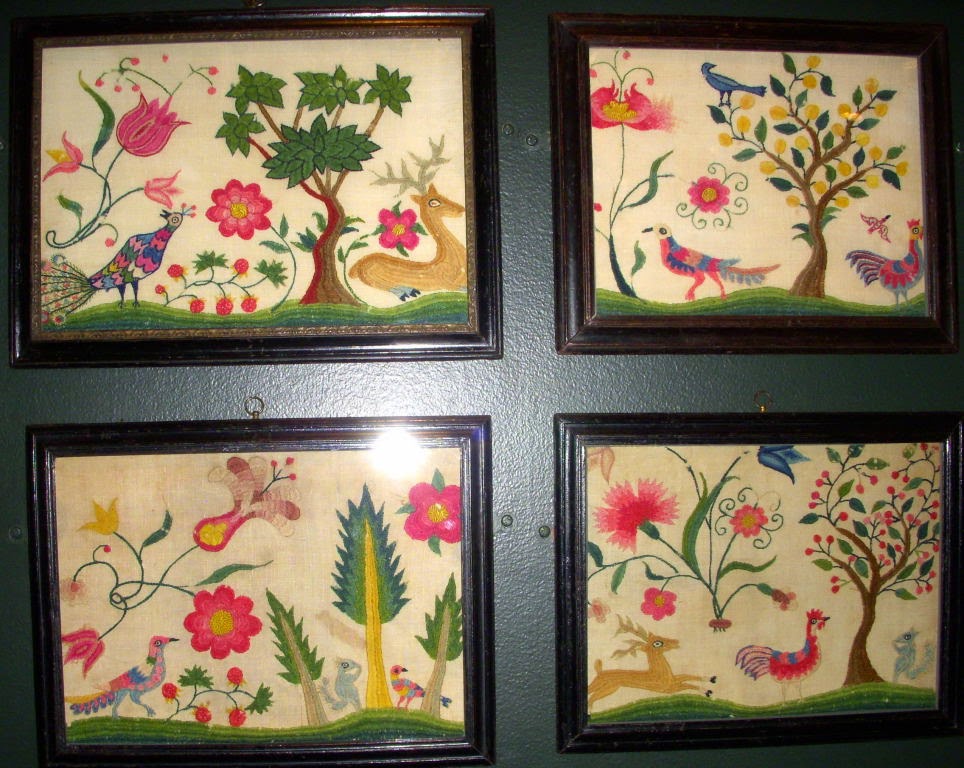Yesterday nine EGA members and friends went on an expedition to Winterthur Museum, in Delaware, an hour and a half trip from Princeton, to the duPont estate as was, and a world class museum of antiques, furniture, porcelain and silver, with a lot of emphasis on fine stitching, works everywhere that you needed a lot more than one day to really see!
On our way in
Here's the entrance to the museum
And the official doorway
It's now open to the public, but until the end of his life the last duPont who had lived there, before he moved to a "cottage" -- huge house on the estate -- added to, and selected, the antiques we see in what is now the Museum, and was able to afford and insist on authenticity at all points. He left us all with a treasure house of antiques, history and the preservation of fine work, particularly that of women.
We had a special insider view, since one of our members arranged for a special behind the scenes tour, sorry, no pix of that one, nothing allowed in our hands, all coats, phones, purses, everything kept secure for us until that part of the day was complete.
Here I can show you Lyn, our tour guide, and Helen H., the EGA member who arranged all this.
And we had the most amazing tour of rooms, furnished as they would have been with the items of the period including wonderful stitching. I loved the men's purses everywhere, in bargello and other fine stitching, casually set down as if a moment ago. And since the light level is kept very low to protect the fabrics from uv rays, there was a theatrical moment at the entrance to each room as Lyn raised the lighting briefly so we could see, and another as she lowered the light again as we moved on. For this stitcher, there was great excitement on seeing in real life embroideries illustrated in Susan Swan's Plain and Fancy. It was like meeting a person whose picture you'd seen.
But the big gasps came when Lyn opened drawer after drawer of wonderful works, to see close up, samplers (three are out on loan to the Morven exhibit I went to a few days ago and blogged about), handkerchiefs, stitching tools, wonderful silk on linen work, endless treasures to see just inches from them. Some family items, where a mother and daughter created works, and they're curated together, or where two sisters worked items, and they're preserved together.
There are two current public exhibits: the Downton Abbey costumes, complete with projections of scenes from the series, some running live with dialog, and historical notes comparing the palatial English country home with the American one of the same era.
Teatime at Downton, note the petit fours in the background, the teabox and the lump sugar!
One example of the American equivalent: a portrait of one of the duPont ladies with her daughter, and her dressing case.
Then the other public exhibit, the initial reason for our trip, before the excitement of the additional private tour: the Diligent Needle exhibit, which examined the use of stitching and sewing for Profit, Pleasure and Ornament.
See the pockets in the case? as a little kid I used to wonder how on earth Lucy Locket could lose a pocket. That was before I came to know that a pocket in those days was tied on.
And for some women, sewing was their livelihood, a very hard one.
The diligence of young girls learning stitching and sewing was part of their upbringing, even if they were not going to have to earn a living by the needle.
Dress designers employed skilled embroiderers for work on their most elegant items, such as this fur trimmed cloak (fur a modern replica of the original trimming) and they do to this day, royal wedding dresses being one example. And the Downton Abbey exhibit has wonderful examples of dressmakers employing embroiderers in their designs.
Here's a sample stitching-store window, in the revival in the late 19th century of stitching as a retail occupation, complete with a work in progress, familiar to sight to most embroiderers.
The curator of this exhibit, Linda Eaton, a friend of one of our group, happened to be in the building and generously gave us time to guide us on this exhibit, explaining how she'd made the decisions about grouping it, how she had located and arranged for some of the pieces to appear, that the title came from an old writing she'd come across, and in general gave us a rapidfire fabulous education in the history of the textile arts. That was a huge bonus, unexpected, she not usually in the building on a Sunday, but she was in midflow of preparing lectures so she was there.
For people local to Princeton NJ, she'll be giving a lecture on January 29th at Morven, in connection with the huge sampler exhibit currently there. I think we'll be seeing her again.






















1 comment:
Oh, how lovely it all is! So glad to have the opportunity to 'visit' thanks to this blog. So proud to be in process of joining the Princeton Chapter, EGA! xo Mare
Post a Comment